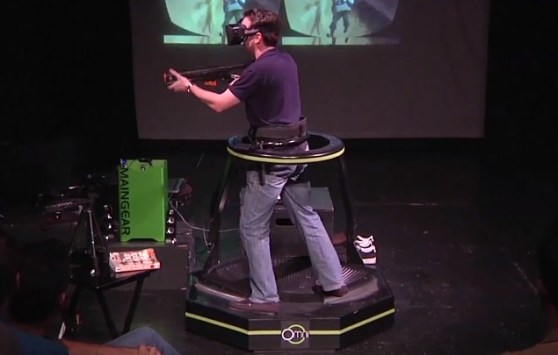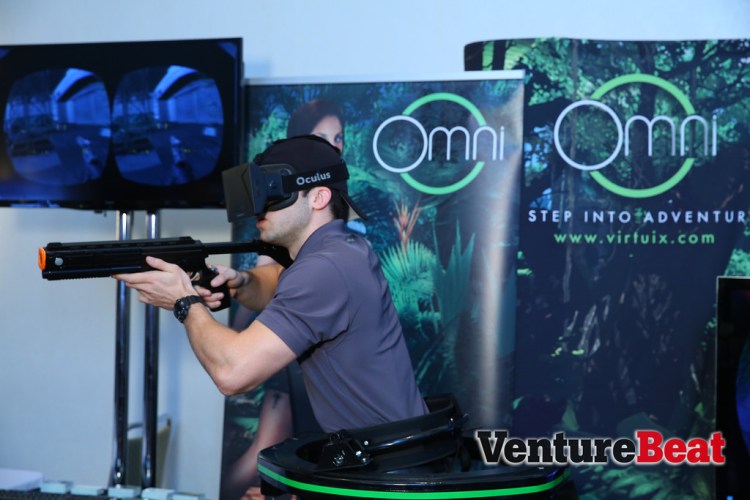GamesBeat: Do you see this thing staying on the PC, or could move to other platforms?
Goetgeluk: I’d be surprised if it just stays with the PC. Virtual reality can easily be extended to other platforms – consoles, mobile, SteamMachines. It takes gaming and general entertainment to this next level of immersion. I’d like to see it extend to other platforms.
GamesBeat: What sort of useful feedback are people giving you? Are there any changes to the design that you’re making, or are you sticking with what you’ve got?
Goetgeluk: So far, the feedback has been overwhelmingly positive. You saw that at GamesBeat. It speaks to the imagination of a large audience. The biggest improvement we’re making right now is with our integrated tracking solution. The Kinect works well, but it’s not flawless. Integrated tracking will be more accurate with less latency. In virtual reality, small changes make a big impact. We’ll keep improving the Omni incrementally and fine-tuning our design.
GamesBeat: What sort of technology is in the Omni?
Goetgeluk: Dozens of patents out there describe these treadmills, but none of them were viable, commercially or technologically. The majority of the Omni is just a mechanical design. It’s an omnidirectional treadmill, but we eliminated all the moving parts. It’s a low-friction surface on which a user can walk naturally, 360 degrees around. I always say that it’s easy to make a complex device. It’s more difficult to make a simple one. We tried to simplify the Omni as much as possible, to make it affordable and compact.
The electronics part is the sensing, with the capacitive sensors in the base. But the tracking itself, that problem had already been solved with different kinds of tracking technology. The real innovation is in the mechanical parts, the treadmill parts, that allows you to walk, run, and jump.
GamesBeat: The harness part, does that just have to be there for the safety side? Or does that play some other role?
Goetgeluk: The harness’s purpose is twofold. One, it does provide safety. You can’t fall off the Omni. Second, it also provides some support, so you can use the Omni hands-free. You can hold a gamepad or some other controller.
GamesBeat: Does that also help you rest a little bit as well, so you’re not always running around?
Goetgeluk: Sure, you could put your weight on the harness for a bit and catch your breath. It’s there to support your full weight.
GamesBeat: What else do you need? If you have an Oculus, if you have the Omni, if you have the peripherals you want to use like a gun you could hold, what other things would work with this? I know the Sixense guys are working on their wireless gesture-control devices. What do you think fits in to help complete the experience?
Goetgeluk: I see full virtual reality as three parts. The first part is visual, which is ready with the Rift. The second part is locomotion, which is the Omni. The third part is tracking – a device that can track your hands, the gun you’re holding, other body parts. That’s the Sixense part. I think the Sixense STEM is probably the best technology out there right now to provide that tracking part.
GamesBeat: What about the touch feedback? Is there some future frontier there as well?
Goetgeluk: Haptic feedback and touch is probably the most difficult nut to crack in an affordable way. A couple of products are trying to accomplish that. One is called Tactical Haptics. They did a Kickstarter last month, but unfortunately they were not successful. They were providing haptic feedback through the controller in your hand. Another device I tried out yesterday is called KorFX. It provides haptic feedback on your chest, simulating bullet hits or other vibrations you might feel. I don’t see this as a crucial part of the virtual reality experience, but they certainly aid in immersion.
 GamesBeat: Is there anyone working on an interesting new experience to show inside something like the Omni?
GamesBeat: Is there anyone working on an interesting new experience to show inside something like the Omni?
Goetgeluk: Not beyond the elements I just mentioned. A couple of different people are working on headsets, in addition to the Rift. A company called Avegant has a headset that projects the image straight into your eye. I tried it out. It’s a high-definition, high-frequency solution. That’s another device coming out on the visual side.
GamesBeat: How about on the game side? Do you hear anything from game developers or publishers?
Goetgeluk: Certainly. We get a lot of communication from game developers who want to develop games for the Omni. Most of them are indies at this point. We did a survey. About 30 percent of our Kickstarter backers intended to make a game for the Omni, which is great news. We want to reach out to developers and get them excited, get our SDK introduced, and get them to make interesting applications.
One beautiful thing about the Omni is that it provides a kind of motion input that hasn’t existed before. If you think of analog walking input, you could match your speed in the game to your speed on the Omni. If you also think about absolute walking orientation, independent of where you’re looking, you can walk forward, look left, and shoot right, all at the same time. Those motion functions don’t exist yet in games, but new games can take advantage of that. That freedom of movement will be an incredible experience.
VentureBeat's mission is to be a digital town square for technical decision-makers to gain knowledge about transformative enterprise technology and transact. Learn More








